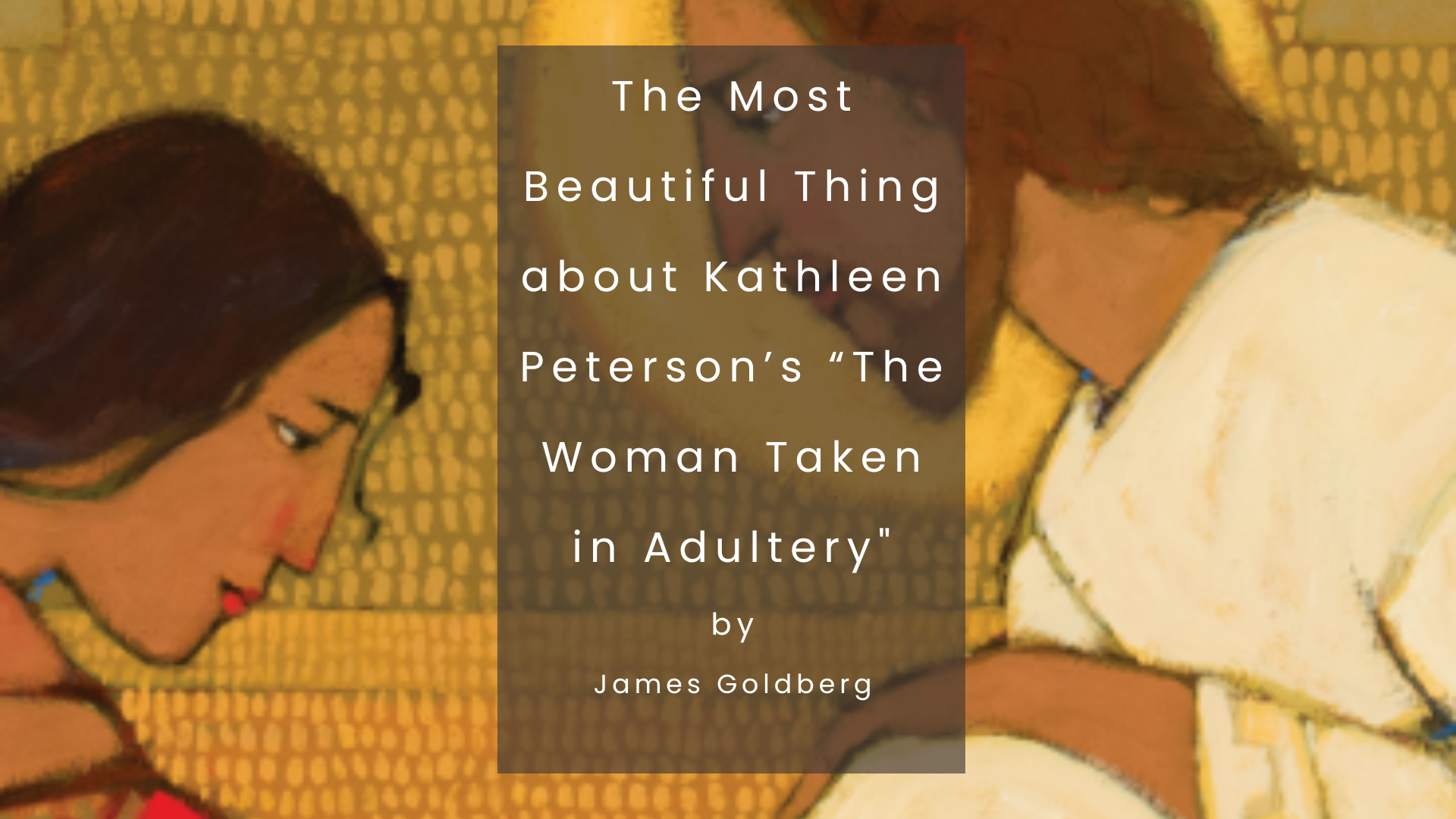Articles/Essays – Volume 53, No. 4
The Most Beautiful Thing about Kathleen Peterson’s “The Woman Taken in Adultery”
1
The most beautiful thing about Kathleen Peterson’s “The Woman Taken in Adultery” is not simply that it is a painting about Jesus. I believe in Jesus. I have spent my life trying to listen to Jesus.
But I am worried we have fallen into the trap lately of believing that the thing Jesus really wants from a religion is more pictures purporting to depict him. More of his name. I worry we are beginning to emphasize the brand “Jesus” while emptying out reminders of all the many ways he relates to us. And that the more we try to wave Jesus like a flag, the more his spirit slips away, forgotten.
Maybe we’re trying to do something good and just missing the mark. Or maybe somewhere along the way, our mark drifted from discipleship to Christianity. To claiming we belong by showing off how Christian we are. How decent.
The quest for respectability is alluring but toxic. It leaves you with little more than the vanity of repetition.
The most beautiful thing about this painting is that it’s still searching for something.
2
The most beautiful thing about this painting is the way the shape of a cross spans clear from alpha to omega. The way its textured light fills the space between who we have been and will be. The taste of grace as day draws toward its close, the setting sun haloing the head of a man whose eyes are looking down. Giving you space outside the gaze that shames.
In this moment, he has bought you a breath.
Religion and ligament share an etymological root. Ligare: a joining, a linking, a binding. Religion is neither about Jesus nor about you—but a thing that happens in the space between. He is looking down, and you are looking down, and something strained thin by the tugs and pulls of this life is knitting itself together again.
In this moment, he has bought you a breath. And the air you breathe is the breath of life, the breath of God.
So breathe. The most beautiful thing is to breathe.
3
The most beautiful thing about this painting is the way the cross bears a pattern from your scarlet clothes. As they were placed there by a single hand in a single moment, a signature of eternity placed before time came to be. Before an ever-shifting now birthed befores and afters. As if the falling and the raising in the history of salvation are one. Were always one.
The most beautiful thing is the symmetry that links the scarlet and the white. The way sin, washed, flows straight into holiness.
The most beautiful thing is the way his left arm, between scarlet and snow, is no longer stretched out in anger. But still.
4
The most beautiful thing is how unlike a commercial this painting is. How little need it feels to glow. How unconcerned it is with showing off Jesus’ virtue by suggesting the power of his shampoo.
It is an easy thing for us to worship commercials. An easy thing for us to worship the shiny hair, the clear white skin, the conventionally good looks. For the way they remind us of wealth and status and the media messaging they’ve been wrapped up in.
The most beautiful thing about this painting is its quiet. The way its message is not shouted from the rooftops but written in the silent, shifting sand.
The most beautiful thing, the most true thing, is a message written only in sand.
5
The most beautiful thing about this painting is that the writing is for her.
Not for them. He’ll never write for them: they’ve had his word already. He speaks to the priests and the scholars, sometimes shouts even. But he doesn’t write for them.
The most beautiful thing about this painting is that the one thing he ever writes is for her.
6
The most beautiful thing about this painting is the brown of the skin on her back, on his face. A Faiyum brown. An Israelite brown. The brown of bodies held at the border of an empire, sneered at with contempt while the proud make gods in their own marble image.
Oh, but the richness of that brown. No marble as beautiful as her hands’ earthen brown. How beautiful upon Mount Zion his brown feet.
Without that shade, the vineyard grows sick. Anemic. Poor Jesus trapped pale in our art.
7
The most beautiful thing about this painting is the quiet hope it gives me. In an hour of frustration, the tiny springtime stir of hope.
This people has blind eyes, You said. Still necks. Hard hearts. Of course we stumble. Of course we stray.
But the most beautiful thing about this painting is this feeling I get: like softening.


 Back to full Issue
Back to full Issue

